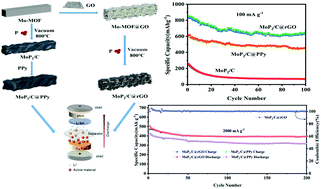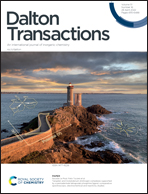MoP2/C@rGO synthesised by phosphating the molybdenum-based metal organic framework and GO coating with excellent lithium ion storage performance†
Abstract
With a high specific capacity, MoP2 has been identified as an ideal electrode material for LIBs. However, the specific capacity is negatively affected due to its poor conductivity and severe volume expansion during insertion and extraction of Li+. In this paper, MoP2-C synthesized by using a Mo-MOF as a precursor, with the generation of C, can effectively solve the agglomeration problem in the synthesis process and alleviate serious volume changes during cycling. Due to the lack of carbon sources provided by a Mo-MOF, the conductivity of MoP2-C cannot be greatly improved. Therefore, rGO and PPy are added to improve the conductivity of MoP2 and further increase the stability of the structure. Compared with MoP2/C and MoP2/C@PPy, MoP2/C@rGO exhibits the highest initial discharge specific capacity of 1208 mA h g−1 at a current density of 100 mA g−1 and rate performances of 830, 750, 630, 550, and 430 mA h g−1 with the current density increasing from 100 mA g−1 to 2000 mA g−1. Notably, the specific capacity remains at 640 mA h g−1 at a current density of 100 mA g−1 after 100 cycles. Followed by 200 cycles at a current density of 2000 mA h g−1, the specific capacity remains at 395 mA h g−1 with a capacity retention rate of 80%.



 Please wait while we load your content...
Please wait while we load your content...